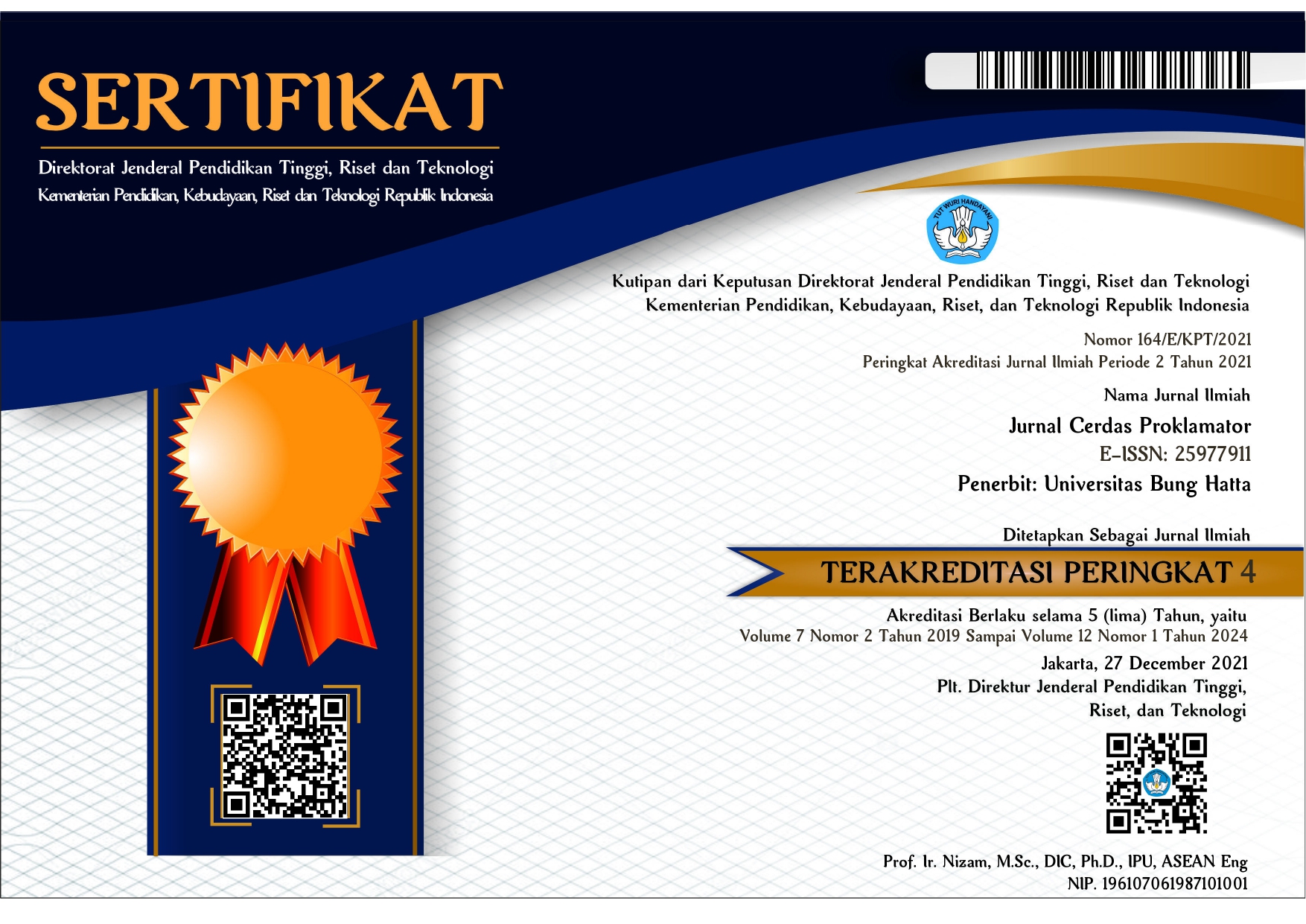KARAKTERISTIK KEMAMPUAN KOORDINASI GERAK BERDASARKAN USIA DAN JENIS KELAMIN SISWA SEKOLAH DASAR
DOI:
https://doi.org/10.37301/cerdas.v10i2.115Keywords:
koordinasi, gerak asia, jenis kelaminAbstract
Tujuan penelitian ini untuk mengetahui Perbedaan Karakteristik Kemampuan Koordinasi Gerak Berdasarkan Usia dan Jenis Kelamin Siswa di Sekolah Dasar Negeri 24 Perupuk Kota Padang. Studi ini dilakukan di antara Siswa berusia 7 – 12 tahun yang berjumlah 120 orang di Sekolah Dasar Negeri Keceamatan Koto Tangah Kota Padang. Sampel tersebar di kelas 1 sampai 6. Masing-masing kelas berjumlah ± 4 siswa yang terdiri dari siswa laki-laki dan perempuan. Instrumen dalam penelitian ini adalah: menggunakan alat Tes koordinasi gerak dari yaitu: (1) balance beam (2) Eye-hand coordination, (3) jumping sideway, (4) moving sideways, dan (5). Data dianalisis dengan (ANOVA) satu arah, untuk menentukan sumber perbedaan uji Tukey HSD dilakukan pada variansn yang homogen. Selanjutnya, sebuah sampel independen t-test digunakan untuk dua kelompok perbandingan. Tingkat signifikansi diambil < 0,05. Hasil penelitian menunjukan terdapat perbedaan karakteristik kemampuan koordinasi gerak siswa usia 7 - 9 tahun dengan siswa usia 10 - 12 tahun, dan terdapat perbedaan karakteristik kemampuan koordinasi gerak siswa antara jenis kelamin laki-laki dengan jenis kelamin perempuan.
References
Bakhtiar, s, Famelia, R., & J Goodway, j. D. (2019). Developing a Motor Skill-Based Curriculum for Preschools and Kindergartens as a Preventive Plan of Children Obesity in Indonesia. Atlantis Press SARL, volume 21.
Colizzi, M., Ciceri, M. L., Di Gennaro, G., Morari, B., Inglese, A., Gandolfi, M., Smania, N., & Zoccante, L. (2020). Investigating gait, movement, and coordination in children with neurodevelopmental disorders: Is there a role for motor abnormalities in atypical neurodevelopment? Brain Sciences, 10(9). https://doi.org/10.3390/brainsci10090601
Ganapathy, S. U., & Monisha, R. (2020). Evaluation of gait and quality of movement analysis in children with developmental coordination disorder. International Journal of Research in Pharmaceutical Sciences, 11(4). https://doi.org/10.26452/ijrps.v11i4.3387
Gonzalez, C. C., Mon-Williams, M., Burke, S., & Burke, M. R. (2016). Cognitive control of saccadic eye movements in children with developmental coordination disorder. PLoS ONE, 11(11). https://doi.org/10.1371/journal.pone.0165380
Gromeier, M., Koester, D., & Schack, T. (2017). Gender differences in motor skills of the overarm throw. Frontiers in Psychology, 8(FEB). https://doi.org/10.3389/fpsyg.2017.00212
Kornspan, A. S. (2014). Contributions to sport psychology: Walter R. Miles and the early studies on the motor skills of athletes 1 . Comprehensive Psychology. https://doi.org/10.2466/32.cp.3.17
Liddy, J. J., Zelaznik, H. N., Huber, J. E., Rietdyk, S., Claxton, L. J., Samuel, A., & Haddad, J. M. (2017). The efficacy of the Microsoft KinectTM to assess human bimanual coordination. Behavior Research Methods. https://doi.org/10.3758/s13428-016-0764-7
Matarma, T., Lagström, H., Löyttyniemi, E., & Koski, P. (2020). Motor Skills of 5-Year-Old Children: Gender Differences and Activity and Family Correlates. Perceptual and Motor Skills, 127(2). https://doi.org/10.1177/0031512519900732
Mottram, S., & Blandford, L. (2020). Assessment of movement coordination strategies to inform health of movement and guide retraining interventions. Musculoskeletal Science and Practice, 45. https://doi.org/10.1016/j.msksp.2019.102100
Palmer, H. A., Newell, K. M., Mulloy, F., Gordon, D., Smith, L., & Williams, G. K. R. (2021). Movement form of the overarm throw for children at 6, 10 and 14 years of age. European Journal of Sport Science, 21(9). https://doi.org/10.1080/17461391.2020.1834622
Piek, J. P., Barrett, N. C., Allen, L. S. R., Jones, A., & Louise, M. (2005). The relationship between bullying and self-worth in children with movement coordination problems. British Journal of Educational Psychology, 75(3). https://doi.org/10.1348/000709904X24573
Pion, J. A, et al. (2015). Stature and jumping height are required in female volleyball, but motor coordination is a key factor for future elite success. Journal of Strength and Conditioning Research, 29(6). https://doi.org/https://doi.org/10.1519/JSC.0000000000000778
Pion, J. A., Fransen, J., Deprez, D. N., Segers, V. I., Vaeyens, R., Philippaerts, R. M., & Lenoir, M. (2015). Stature and jumping height are required in female volleyball, but motor coordination is a key factor for future elite success. Journal of Strength and Conditioning Research, 29(6). https://doi.org/10.1519/JSC.0000000000000778
Robert, M. P., Ingster-Moati, I., Albuisson, E., Cabrol, D., Golse, B., & Vaivre-Douret, L. (2014). Vertical and horizontal smooth pursuit eye movements in children with developmental coordination disorder. Developmental Medicine and Child Neurology, 56(6). https://doi.org/10.1111/dmcn.12384
Santos, C., Bustamante, A., Hedeker, D., Vasconcelos, O., Garganta, R., Katzmarzyk, P. T., & Maia, J. (2020). A multilevel analysis of gross motor coordination of children and adolescents living at different altitudes: the Peruvian Health and Optimist Growth Study. Annals of Human Biology. https://doi.org/10.1080/03014460.2020.1742378
Sarmiento, C., & Lau, C. (2020). Diagnostic and Statistical Manual of Mental Disorders, 5th Ed.: DSM?5. In The Wiley Encyclopedia of Personality and Individual Differences. https://doi.org/10.1002/9781119547174.ch198
Sengkey, A. R. J. (2019). The impact of self-regulation on motion coordination ability for Elementary School students. Journal of Physics: Conference Series. https://doi.org/10.1088/1742-6596/1360/1/012014
S?owi?ski, P., Baldemir, H., Wood, G., Alizadehkhaiyat, O., Coyles, G., Vine, S., Williams, G., Tsaneva-Atanasova, K., & Wilson, M. (2019). Gaze training supports self-organization of movement coordination in children with developmental coordination disorder. Scientific Reports, 9(1). https://doi.org/10.1038/s41598-018-38204-z
Syahputra, R., Mardiansyah, A., Ade, A., Bakhtiar, S., & Pion, j. (2021). Sistem Indetifikasi Bakat dalam Olahraga. Weneka Media.
Volkov, P. B., & Nagovitsyn, R. S. (2018). Gaming technologies in the development of spine flexibility and the coordination of children and teenagers’ movements in sports classes in country health camps. Pedagogics, Psychology, Medical-Biological Problemsof Physical Training and Sports, 22(1). https://doi.org/10.15561/18189172.2018.0107
Whittaker, J. L., Booysen, N., De La Motte, S., Dennett, L., Lewis, C. L., Wilson, D., McKay, C., Warner, M., Padua, D., Emery, C. A., & Stokes, M. (2017). Predicting sport and occupational lower extremity injury risk through movement quality screening: A systematic review. In British Journal of Sports Medicine. https://doi.org/10.1136/bjsports-2016-096760
Živanovi?, V., Brankovi?, D., & Pelemiš, V. (2018). Gender differences in children related to the body composition and movement coordination. Croatian Journal of Education. https://doi.org/10.15516/cje.v20i1.2604
Downloads
Published
Issue
Section
License
Copyright (c) 2022 Jurnal Cerdas Proklamator

This work is licensed under a Creative Commons Attribution 4.0 International License.
Copy right in each article belong to the authors.
1. The author acknowledges that the Journal Cerdas Proklamator as a publisher who publishes for the first time with the
Creative Commons Attribution 4.0 International License.
2. The Author can enter the writing separately, manage the non exclusive distribution of manuscripts that have been published in this journal into the other versions (eg sent to the repository of the author's institution, publication in book, etc), by acknowledge that the manuscript was first published in the Jurnal Cerdas Proklamator.
























